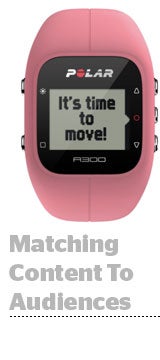Targeting a running watch to a broad group like “runners” on Facebook doesn’t cut it anymore.
Bold Worldwide, a social media agency with a roster of sports-focused clients, advocates that its brands – including running and cycling watch Polar – massively increase the amount of content they create. With more versions of ads, they can design messages that will resonate with casual joggers as well as marathoners or triathletes.
Bold then uses Facebook to distribute that wide variety of content to the narrow pockets of consumers where that it feels just right for them.
It’s a simple approach, but one that agencies often talk about more than they actually execute, said Brian Cristiano, CEO of Bold Worldwide.
“This was the promise of digital – but no one did it,” Cristiano said. “The vast majority of agencies and brands don’t do it because it’s a lot more complicated, time-consuming and takes more resources than shooting a big commercial and running it for a few quarters.
In January, the agency kicked off one such campaign for Polar, which signed on as a client less than two years ago, when it spent most of its budget in traditional media.
Following a short video shoot, the agency created a branding video featuring six athlete sponsors, individual videos with long-distance track star Molly Huddle and Ironman triathlete Andy Potts and videos featuring only runners or cyclists.
“[Understanding] what’s meaningful to each audience segment … enables us to serve the most relevant content,” said Gina Pilnacek, senior marketing director at Polar. “We can foster the right conversations to develop sustained relationships, rather than fleeting, transactional ones.”
Once videos start running on Facebook, Bold optimizes those different content types in a few ways.
If a piece of content works better with women instead of men, Bold may target the ad only to that group. Or, if it finds that a piece of content skews to one age group more than others when it wants to reach audiences of all ages, for example, it can try to create content to fill that gap.
Bold Worldwide also looks at creative targeting as a way to drive people down a funnel.
If someone completes a video about Huddle, who runs long distances, maybe he or she next will receive a piece of content about picking their next marathon, followed by specific product recommendations, Cristiano said. “We will see who is interacting and more engaged and will promote certain products to them at the right time.”
The agency also will retool creative where needed. Every brand or audience has a different attention span for content, Cristiano said. So when Bold found that drop-offs peaked in the eight- to 10-second range for the branding video, it reworked the video. Splashier pieces of the content now run before the drop-off point.
Bold Worldwide uses the more-targeting-and-creative approach for many of its clients, but getting brands on board means upending how marketers and their finance teams traditionally think of media budgets. In the days when TV reigned, a single TV commercial could run for months. That approach will sink brands on digital media, Cristiano said.
“There is still too much emphasis put on spending the vast majority of the budget on the media, with a tiny sliver on creative,” he said. “We need to be spending more money on the creative side and be smarter about how we are spending the media so that it actually creates an impact.”














